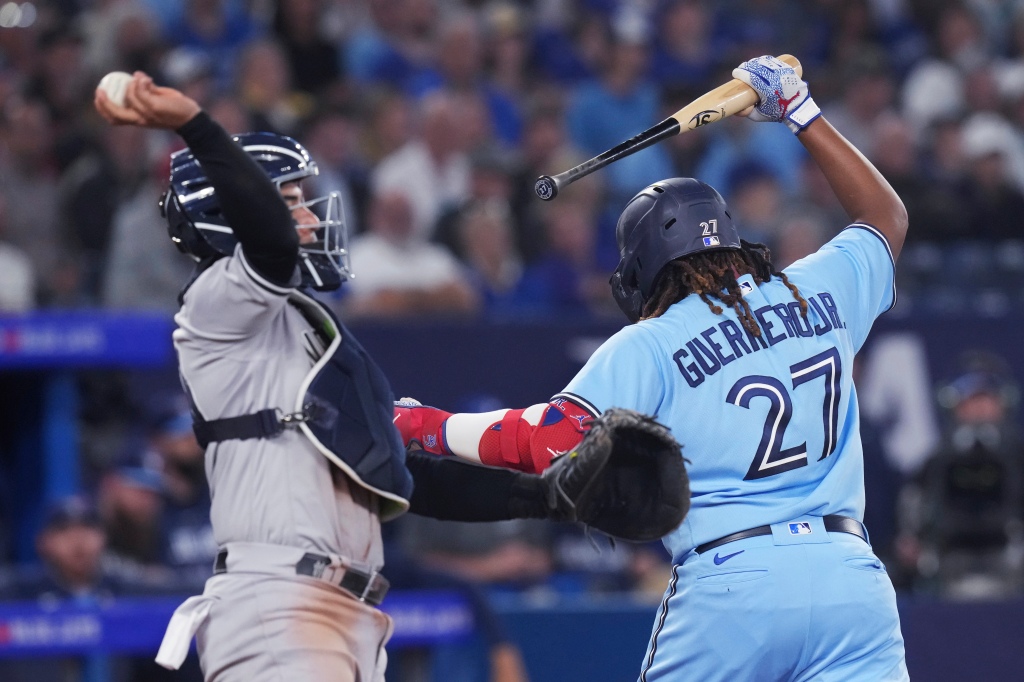I want to test-drive a theory, so thank you in advance for stopping by.
It is an idea that has been forming the past two weeks as I watched the Yankees play a home-and-home series over two weekends with the Rays before heading to Toronto.
I think the games within the AL East are going to be, in general, thrilling and theatrical; dramatic and traumatic; passionate and poignant. They have been so far.
The Yankees played seven games against the Rays. Six were decided by one run. Most felt like the best kinds of heavyweight fights. Back and forth. Skill and will merging.
Then at the Rogers Centre, conspiracy and consternation flowed. Where was Aaron Judge darting his eyes? How petty could each team get about the positioning of base coaches? What was on Domingo German’s hands? And just who was “fat boy”?
Why are we getting this within the AL East, and why do I think it will continue?
OK, here is my theorem: Fewer games against each other plus top-to-bottom excellence equals the heightened meaning of each of these games — and the teams know it.
The return of the balanced schedule this year reduces the number of intra-division games against each opponent from 19 to 13. That is 24 fewer games within the division.
Generally, what is rare is valuable (see also: diamonds and classic first-edition books). The Yankees and Blue Jays completed their first home-and-home series Thursday. The next time they see each other is to start the Yankees’ final homestand on Sept. 19 and to start the Yankees’ final road trip on Sept. 26.
The saying is familiarity breeds contempt. But the lack of it this year is going to elevate contempt and competition.
You know the rule on division matchups: They are worth two games in the standings — the one you win and the one they lose. And now there are fewer opportunities to create that kind of swing. And it is becoming evident just how precious each win and loss will be in this division.
All five AL East teams are at least four games over .500 and plus-16 in run differential. But if the season ended Thursday, the Red Sox would not have made the playoffs and the Yankees and Blue Jays would have eked in by a half-game.

Much has been made about the Rays pumping up their record in games outside the division. They are 10-7 against the AL East and 22-6 vs. every other club. First, 10-7 is a .588 winning percentage, which is excellent against any competition. Second, it is the best intra-division record in the AL East. The Blue Jays are 5-9 within the division, the Orioles are 6-6, the Red Sox are 7-7 and the Yankees are 9-8. The Red Sox’s performance was symbolic: Not only were they .500 in AL East games, but they had scored 85 runs and given up 85 runs.
The quality of the teams, the meaning of the games and just having fewer of them in stock promises to bring out the best — and worst (see: “fat boy”) — in all five clubs.
Historically, the competition and contempt was intensified in Yankees-Red Sox series. In recent years, Yankees-Rays did a fine imitation. But I sense the reduction of head-to-head games and the abundance of quality teams is going to increase the significance and stress levels in these AL East tilts.
It is why in this week’s Awards Watch, I am ranking the divisions to date, and, if we were being fair, a ballot might look like this: 1. AL East. ……….. 6. Five-way tie.
That is the distance between the AL East and the other divisions.

The AL West, for example, has four teams with positive run differentials, but just three over .500 (the Angels are 23-22) and also contains by far the worst team in the majors — the 10-35 A’s, who have a minus-161 run differential.
Also, consider that AL East teams were 98-51 in games outside the division, a .658 winning percentage. The next best is the NL West at 74-70 (.514). The NL East is next at 77-76 (.503). Then the NL Central 79-88 (.473), the AL West 69-80 (.463) and AL Central 64-96 (.400). In the AL Central, the Twins are 24-20 with a plus-42 run differential. The other four clubs are a combined 69-105 with a minus-204 run differential.
I will pardon the AL West for having the A’s because the other four clubs range from average to above-average, and I would put that division second behind the AL East, followed by the NL West, NL East, NL Central and AL Central.
Whose career do you got?
I have been part of the committee the past few years that decides which players who have played in 10 seasons and have been retired for five years should be put on the Hall of Fame ballot.
It is an enjoyable chore for a few reasons. But it reminds me about the kind of very good career that is likely to fall short of the Hall. Yet, wow, look at the totality of it all. It is a top 5 or 10 percent career all-time. It is the kind of career that moves me to recommend putting the player on the ballot, partially in the hope that one day the revealing of the ballot comes with a little more pomp to recognize the outstanding but not immortal player.
My suspicion is that one day Josh Donaldson and Justin Turner will fall into this category. It is hard to see one making the ballot and not the other. Namely because there are so many similarities between the pair, which is why they are featured in this week’s “Whose career do you got?”
In its most simplistic form, these two are late-blooming third basemen. Donaldson was not a regular and difference maker until his age-27 season, Turner not until 29.

Donaldson has an edge in bulk numbers, but does Turner compensate (and more) with his fantastic bulk work in the postseason? Donaldson broke in at 24, and is in his age-37 season. Turner broke in at 24, and is in his age-38 season.
Want a quirky similarity?
Donaldson in his career has 40 steals with 10 caught stealing. Turner has 43 steals with 10 caught stealing.
Donaldson won the 2015 AL MVP, has two fourth-place finishes and has received MVP votes in six years. Turner has received MVP votes in three years, never finishing higher than eighth. Turner was good at third base, but Donaldson is viewed as the better defender.
For their careers:
Donaldson: 5,684 plate appearances, 267 homers, .264/.361/.491, 131 OPS-plus, 42.8 WAR
Turner: 5,336 plate appearances, 169 homers, .289/.366/.465, 125 OPS-plus, 36.0 WAR
In 46 career postseason games and 203 plate appearances, Donaldson is .246/.335/.397 with five homers.
In 86 career postseason games and 368 plate appearances, Turner is .270/.370/.460 with 13 homers. Plus, he was the 2017 NLCS MVP, and when the Dodgers won it all in 2020, Turner hit .320 with six extra-base hits and a 1.066 OPS in six World Series games against the Rays.

Their 10-year primes also are comparable: From 2012-21, Donaldson had a slash line of 270/.368/.506 with a 136 OPS-plus.
From 2013-22, Turner was .295/.273/.485 with a 132 OPS-plus.
But note, Donaldson’s run ends in 2021. He was bad last season (94 OPS-plus) and then abysmal in the postseason (5-for-29, no RBI, 16 strikeouts). He was off to a poor start again this year (.125 average in five games) before going to the IL because of a hamstring injury.
Turner still posted a 118 OPS-plus last year, and had a 115 OPS-plus this year for the Red Sox, mainly as a first baseman/DH.
So he may be able to add to his resume better than Donaldson will in his twilight years.
The book is not closed yet on either player. But, for now, whose career do you got?
Got my attention
There was so much improbable about the Mets’ 8-7 comeback victory in 10 innings Wednesday night against the Rays.
But here is one that might have eluded your radar:
The Rays were 7-for-7 in stolen base attempts — and lost.

The last time a team had at least seven stolen bases without being caught and still lost was Sept. 16, 2011. The Rays were the losers that time, too, 4-3 against the Red Sox. Six of the seven steals were against the battery of Josh Beckett and Jason Varitek; the last was against Jonathan Papelbon and Jarrod Saltalamacchia.
Johnny Damon stole three bases in that game for the Rays, Desmond Jennings had two and Casey Kotchman and B.J. Upton had one each. The only player who appeared in that game who is still active was Red Sox reliever Daniel Bard, now with the Rockies.
Between Sept. 16, 2011, and May 17, 2023, eight teams had stolen at least seven bases in a game without being caught, and all eight won.
Roster stuff maybe only I notice
Kole Calhoun has an out of his minor league Yankees contract on June 1. He is one of multiple veteran lefty hitters the Yankees imported to try to give them depth options on the side of the plate where they have been short of options in recent seasons.
Heck, the Yankees cornered the market on both active lefty-swinging Calhouns — Kole and Willie.
Besides the Calhouns, there are Jake Bauers, Franchy Cordero, Billy McKinney, switch-hitter Wilmer Difo and even Estevan Florial, who was removed from the 40-man roster when the Yankees needed to get emergency arm Colten Brewer to the big leagues earlier in the season, but cleared waivers and went to Triple-A.

Kole Calhoun didn’t make the Mariners out of camp, and was released from his contract. The Yankees signed him to a minor league deal, and he had an initial six-game burst at Triple-A during which he was 11-for-22 with three homers, four walks and four strikeouts. In his next five games, Calhoun went 2-for-22 with nine strikeouts.
Whether he stays or leaves is a smaller part of two bigger-picture Yankees issues:
1. The Yankees’ overall left-handedness. In 2016, the Yankees took the majors’ second-most lefty plate appearances (3,628). They have not been in the top half of the league since, finishing 17th in 2017, 22nd in 2018, 27th in 2019, 30th in 2020, 28th in 2021 and 22nd in 2022.
They were 25th this season (through Wednesday).
The rightward shift happened as the Yankees’ fixation became on what they perceived as adding the best players in the draft, internationally and in trades — and not on left-right balance. So the arrival of players such as Miguel Andujar, Clint Frazier, Aaron Judge, Gary Sanchez, Giancarlo Stanton, Gleyber Torres and Luke Voit brought a strong tilt to the right.
Often, the Yankees had righties who hit righties well plus had opposite-field power to capitalize on the short porch in right field. But the lack of lineup balance was often exposed in the postseason, when opponents could use power righty relievers to go through large swaths of the Yankees lineup.

Deadline trades for Joey Gallo and Anthony Rizzo in 2021 was in recognition of needing greater balance. The Yankees’ past three first-round draft picks also have been lefty hitters in Austin Wells, Trey Sweeney and Spencer Jones; plus their top prospect, Jasson Dominguez, is a switch-hitter.
And their binge of lefty depth pieces such as the Calhouns, Bauers, etc., is no accident. There are a greater number of games now in which the Yankees use three or four lefty hitters against a righty starter. In this week’s series opener against the Blue Jays, they used five.
But what is noticeable is how infrequently Aaron Boone was starting Aaron Hicks against righties. Hicks started Thursday against Toronto’s Jose Berrios, his second start in the past seven games the Yankees had against a righty starter. Hicks went into that game 4-for-45 against righty pitching, then went 3-for-4.
That leads to question 2 …
2. How long do the Yankees stick with Hicks? The Yankees said Wednesday that Giancarlo Stanton was nearing a rehab assignment. Stanton certainly leads the majors in the category during recent seasons: nearing rehab assignments.
When Stanton returns and Josh Donaldson does, the need for the switch-hitting Hicks to start even against righties will go way down, if not vanish entirely. And already Hicks is hardly starting against lefties. So what does that leave?
Boone is showing an affinity for Willie Calhoun and especially Bauers over Hicks. Neither Calhoun nor Bauers has minor league options remaining, and there is a decent chance that at least Bauers would be claimed on waivers if the Yankees tried to send him down.

If the Yankees get Donaldson and Stanton back without losing anyone else (don’t laugh), they are sure things on the roster along with Kyle Higashioka, Jose Trevino, Anthony Rizzo, Torres, Anthony Volpe, DJ LeMahieu, Harrison Bader and Judge.
That’s 10. So it would leave three slots for Hicks, Calhoun, Bauer, Oswaldo Cabrera and Isiah Kiner-Falefa. Cabrera could be optioned, and his poor offense could justify it. But if you were going to retain a switch-hitter with offensive problems, would you keep a guy who can play every position with competence or better or would you keep Hicks? Kiner-Falefa is a righty contact bat with speed who can play all over the field — a decent 26th man. Then there are Bauers and Calhoun, and Boone already has shown his favoritism.
This week on “The Show with Joel Sherman and Jon Heyman” podcast, Hal Steinbrenner said he would eat money if his baseball officials recommended it as the best way to help the 2023 team win. Hicks is due about $26.7 million through the 2025 season.
Last licks
The ejections of Max Scherzer and Domingo German for what was deemed illegal sticky stuff both occurred when they were taking the field for the fourth inning.
The standard is that umpires check the starting pitchers when they leave the field after a half-inning of pitching. But if the hope is to curtail excessive (and illegal) sticky stuff, some unanticipated checks on the way to the mound should become routine.
Think about it: The check for the illegal — at airports, ballparks, clubs, etc. — is on the way in, not the way out.

The rule is that a pitcher cannot apply even legal rosin in the dugout. It has to be what is on the mound. So, the pitcher should arrive to the mound without anything sticky on his hand (though pitchers have told me it is hard to clean even legal rosin quickly and completely between innings, and pitchers do not want to overwash and soften their hands between innings).
Now, a pitcher can hide a substance somewhere that’s not on his hands and potentially avoid detection. But this would add another layer of examination to discourage the behavior.
The debate also continues over whether the umpires really can distinguish between what is often described as the tackiness of legal rosin and the stickiness of illegal substances. It calls for a new reality series: “CSI: Pitcher’s Mound.” In a moment when there are questions about what is on a pitcher’s hands, a trained criminologist in a hazmat suit comes out and swabs the alleged culprit’s hands. Then it is off to the labs and microscopes.
You are telling me that if the reading of the results were put on the MLB Network live that it wouldn’t draw an audience?
Criminologist into the TV camera: We have deemed the substance is an illegal combination of Elmer’s glue and silly string.
Yes, there’s some absurdity here (though I do think people would watch).

But there is some absurdity as part of the sticky practice. It seems that we are going to get some scripted elements to sticky-stuff ejections.
In both cases this year, the crew chief said in the aftermath that it was the stickiest substance they had ever encountered on a baseball field.
I wonder what will be said when a crew chief has a second ejection this year. This is the stickiest stuff ever, the sequel?
And both Scherzer and German said part of the reason they did not appeal their suspensions was that they learned that an MLB official, not a neutral arbitrator, hears the case, pretty much removing the chance of winning the appeal.
First, this is not new. It is collectively bargained. Second, if you are innocent or feel there are extenuating circumstances, putting it on paper to potentially exonerate yourself or set a precedent for the next accused pitcher has value.
And I guess if one player paid it forward to help the next player in trouble, he would be described by his peers as, well, a glue guy.
That is no way to head to vacation, I know. Yet there I go. See everyone back here in two weeks.


